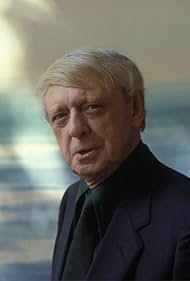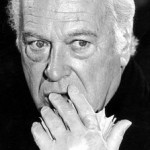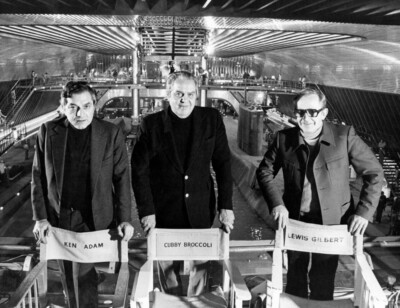 The ‘alternative’ versions of Bond history have always proved beguiling to 007 fans. In a fascinating article for a British newspaper, best-selling author and James Bond expert Jeremy Duns has described the events that led to him gaining access to what was assumed to be the ‘lost’ script penned by Anthony Burgess for The Spy Who Loved Me.
The ‘alternative’ versions of Bond history have always proved beguiling to 007 fans. In a fascinating article for a British newspaper, best-selling author and James Bond expert Jeremy Duns has described the events that led to him gaining access to what was assumed to be the ‘lost’ script penned by Anthony Burgess for The Spy Who Loved Me.
Writing for the online version of the UK’s Daily Telegraph newspaper (2nd February), Duns also revealed some of the intriguing story details that were created by Burgess (pictured) for the script.
In 1975-76, as the by now rather volatile partnership between Harry Saltzman and Albert ‘Cubby’ Broccoli came to an end, and the second Roger Moore adventure The Man With the Golden Gun (1974) had disappointed film critics, Cubby found himself under a lot of pressure to re-energize the franchise and come up with something really special for his first solo movie as producer. He and the then-director Guy Hamilton had decided to use Ian Fleming’s title The Spy Who Loved Me for Roger’s third movie as 007, but they needed an exciting and original script for the new adventure, something that would be on a more ‘epic’ and memorable scale. They decided to cast their net widely and approach various authors for the task.
In early 1975, Anthony Burgess (1917-1993), the acclaimed author of the dystopian novel A Clockwork Orange (1962) and other literary successes, was in New York as part of a lecture tour when he was approached outside his hotel by Broccoli and four-times Bond director Hamilton. According to Duns, the pair asked Burgess to write an original script for the The Spy Who Loved Me (Ian Fleming had stipulated that only the title could be used from his novel of the same name, a book that had not been well-received by critics when it was published back in April, 1962). Burgess agreed, as he was a huge admirer of the books of Ian Fleming and had himself written a spy thriller, Tremor of Intent, in 1966, a book which contained ‘Bondian’ elements.
Burgess and Bond
What Burgess actually came up with was outlandish and, indeed, simply too bizarre for the Bond producer to take seriously. In fact, it seems that Burgess himself knew that what he was writing would not be acceptable to the film-makers, but he ploughed on anyway. Once thought lost, the script by Burgess, which was not taken up by Broccoli, appears to have survived in a 44-page outline form, and Jeremy Duns was able to reveal some of its main contents to Telegraph readers.
It is intriguing material. Instead of SMERSH or SPECTRE, the main villainous organization at the heart of the script was the ‘Consortium for Hastening the Annihilation of Organized Society’, C.H.A.O.S. for short. As described by Burgess, after a power struggle, a man named Theodorescu emerges successfully as the third and dominant leader of CHAOS, and – as a man with a nihilist philosophy (with no values or concern for others) – he has some dastardly plans to destroy human civilization just for the thrill of it.

Interestingly, Theodorescu works out of a tanker in the Pacific Ocean (which is possibly one of the only elements that was retained for what eventually became the actual script for The Spy Who Loved Me in 1976-77, where baddie Karl Stromberg also employs a tanker for his destructive scheme). In another possible nod to the Roger Moore version of Bond, 007 would have been a cigar-smoking figure, but with apparent abilities to dish out ‘alternative’ medical advice, including to Miss Moneypenny. CHAOS would have been involved in blackmailing the Pope and exorting several world leaders to indulge in sexual acts. In addition, the Archbishop of Canterbury is also blown up on a plane after he has donned headphones to watch a movie called The Spy Who Loved Me (!). Burgess, a lapsed Catholic, had something of a love-hate relationship with organized religion, and often injected satirical elements into his writings.
In another sign that Burgess was writing with his tongue firmly in his cheek, CHAOS would also be running a Bavarian clinic headed by a frugal Scottish doctor named ‘Fleming’. And the devious Dr. Fleming would be secretly inserting minature nuclear devices into the clinic’s patients, to be detonated at a later stage in the global takeover being planned by CHAOS. Some Australian locations would also have featured in the plot, including at Sydney Opera House in the climax to the movie.
As Duns noted, it is probably no surprise that the film treatment penned by Burgess was not taken up by Broccoli. The movie that eventually went into production, directed by Lewis Gilbert after Guy Hamilton withdrew, had a screenplay by Christopher Wood and Richard Maibaum, and ironically owed much to You Only Live Twice (1967). It would seem that Broccoli had decided that the treatment by Burgess, and others that were also secretly commissioned, had been far too risky, and the tried-and-tested formula of a previous Bond movie seemed a much safer bet.
In hindsight, Broccoli was proved right, of course. Roger Moore’s third Bond film is now regarded by many (which included the late Sir Roger himself) as a hugely successful movie, with some classic ‘Bondian’ moments. But what Duns has revealed in his exploration of the unused Burgess treatment throws important new light on one of the ‘what might have been’ moments in Bond movie history.

Ken Adam, Cubby Broccoli and Lewis Gilbert on the set of Stromberg’s supertanker at Pinewood Studios.
